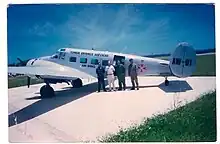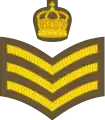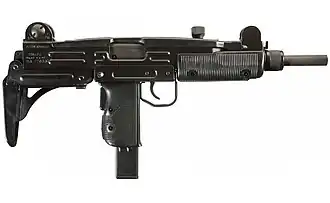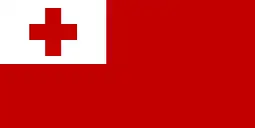His Majesty's Armed Forces (Tonga)
His Majesty's Armed Forces (HMAF) is the military of Tonga. It is composed of three operational components and two support elements (logistics and training groups).
| His Majesty's Armed Forces | |
|---|---|
 Coat of arms of His Majesty's Armed Forces | |
 Flag of the Armed Forces | |
| Motto | Terra Marique (Latin) ("Land and Sea") |
| Founded | 1939 |
| Current form | 2013 |
| Service branches | Tongan Land Component Maritime Force Tongan Air Wing Tongan Training Command Tongan Support Unit |
| Headquarters | Vilai Barracks, Nuku'alofa |
| Leadership | |
| Commander-in-Chief | HM King Tupou VI |
| Minister for HMAF | Siaosi Sovaleni |
| Chief of Defense Staff | Brigadier General Lord Fielakepa |
| Personnel | |
| Military age | 18 |
| Conscription | None |
| Available for military service | 34,254 males, age 16-49 (2010 est.), 32,974 females, age 16-49 (2010 est.) |
| Fit for military service | 27,404 males, age 16-49 (2010 est.), 28,509 females, age 16-49 (2010 est.) |
| Reaching military age annually | 1,448 males (2010 est.), 1,392 females (2010 est.) |
| Active personnel | 500[1] |
| Expenditures | |
| Percent of GDP | 0.9% GDP (2006 est.) |
The mission of HMAF is to: "Defend the sovereignty of the Kingdom of Tonga".
The HMAF is partially supported by defence co-operation agreements with Australia, the United States, China, India and New Zealand. The co-operation aims at capacity development through training of HMAF personnel in leadership, academic and trades while support for infrastructure development is another part of the security co-operation.
In recent years, members of HMAF have supported Coalition of the Willing in Operation Iraqi Freedom, the International Security Assistance Force in Afghanistan, and the Regional Assistance Mission to the Solomon Islands.
History

Tonga participated in World War I, as part of the New Zealand Expeditionary Force.
The Tonga Defence Service (TDS) came into existence at the beginning of World War II in 1939. In 1943, New Zealand helped train two Tongan contingents of two thousand personnel who fought in the Solomon Islands Campaign.[2] In addition, New Zealand and US troops were stationed on Tongatapu, which became a staging point for shipping.
At the end of World War II, the TDS was disbanded, but was re-formed in 1946.[2]
Former Prime Minister Prince Lavaka Ata 'Ulukalala (now King Tupou VI) joined the naval arm of the Tonga Defence Service in 1982 and became Lieutenant-Commander of the defence force in 1987. From 1990 to 1995 he commanded the PPB VOEA Pangai and his time in charge included peacekeeping operations in Bougainville.
In 2002, TDS soldiers were deployed as part of a multi-national regional peacekeeping force in the Solomon Islands. In July 2004, a forty-five personnel contingent of the TDS served in the Solomon Islands. A third contingent was sent in July 2005.[2] This contingent consisted of thirty-three TDS troops, and was expected to remain four months.
In March 2003, military-to-military talks began between Tonga and the United States about Tonga providing personnel for the Multinational force in Iraq. Support arrangements were finalised in May 2004. Forty-five Royal Tongan Marines, led by the Chief of Defence of the Tonga Defence Services, Colonel Tau'aika 'Uta'atu, departed Tonga on 13 June 2004. From July 2004, the Royal Tonga Marines were augmenting the 1st Marine Expeditionary Forces (MEF) in the Al Anbar Province of Iraq. The Royal Marines supported the 1st Marine Division's security and stabilisation mission at Camp Blue Diamond. Tonga first served with the 1st MEF on the Solomon Island during World War II. The Royal Tongan Marines returned from Iraq in December 2004. In December 2008, the Tonga Defence Services ended their mission in the Iraq War and returned home.[3]

In 2006, TDS soldiers, in co-operation with local police, were deployed to deal with the Nuku'alofa riots.[2]
In 2010, Tongan troops began training with the RAF Regiment, in preparation for operations in Afghanistan; the first troops deployed to Afghanistan during February 2011.[4] Tonga's military size was approximately 450 troops, half of which were sent to fight in the War in Afghanistan, serving in Camp Bastion and Camp Leatherneck.[5][6] During the September 2012 Camp Bastion raid Tonga troops were in perimeter guard towers without any night-vision devices.[7] In September 2013, Tonga Defence Services were officially renamed into His Majesty's Armed Forces (HMAF).[8] In April 2014, the Royal Tongan Marines ended their mission supporting Operation Enduring Freedom in Afghanistan.[6]
Components
The main elements of HMAF are:[9][10]
- His Majesty's Armed Forces HQ
- Joint Force HQ
- Land Force
- Tongan Royal Guards
- Royal Tongan Marines
- Combined Logistics and Technical Support
- Tongan Navy
- Training Command
- Air Wing
- Support Unit
- Territorial Forces
Tongan Maritime Force (Tongan Navy)
_-_RAN-IFR_2013_D3_74.jpg.webp)
The Maritime Force is equipped with three Pacific-class patrol boats, a tanker, a Landing Craft Mechanised and a motor boat that is the royal yacht.[11] Tongan Maritime Force performs patrol missions, occasionally dealing with border violations, at the Minerva Reef and Tonga's restricted fishing zones.[2]
Royal Tongan Marines
The Royal Tongan Marine Infantry is organised as a single battalion with a HQ and three Light Infantry Companies.
Tongan Royal Guards
The Tongan Royal Guards are a company size unit that are responsible for the security of His Majesty. The Royal Guard maintains a musical unit known as the Tonga Royal Corps of Musicians that serves as a military band for different occasions.
Tongan Air Wing
The Air Wing was established in 1996 under the command of Colonel Fetu'utolu Tupou at the request of Crown Prince Tupouto'a as Minister of Defence. The Crown Prince wanted Tonga to have its own maritime patrol and search and rescue capability rather than having to rely on New Zealand and Australia's Orion aircraft. The US State Department was consulted for advice and presented a proposal for a Beech King Air at a cost of US$3 million. As $3 million was 10% of the annual national budget, His Royal Highness contacted Peter Goldstern who was operating seaplane flights to the volcanic island of Tofua for his opinion which after extensive research and a trip to the Oshkosh air show proposed a Beechcraft G-18 for a price of $300 thousand. The proposal was approved and a suitable aircraft located in Nome, Alaska. Mr. Goldstern flew the aircraft to Seattle where a surveillance radar, forward looking infrared, direction finding avionics, and a sliding door for life raft deployment were installed. On completion of the modifications, Mr. Goldstern made the 5000 mile trip to Tonga arriving on July 4, 1966. shortly thereafter an American Champion Citabria was purchased to facilitate pilot training in Tonga. Until 2000, the Beech aircraft was operated successfully by Mr. Goldstern for The Air Wing on search and rescue missions and fisheries surveillance. In this year, Colonel Tupou was reassigned as High Commissioner to London and command was assumed by Col. Uta'atu who decided to defer to New Zealand and Australian military advisors who thought little of a 40 year old aircraft and recommended reliance on their aerial capabilities together with Tonga's navy. Since 2000 neither aircraft has been operational.

Retired Aircraft
- Victa Airtourer 1 aircraft.
International Defence Organisations
The HMAF is a member of the following international defence organisations:
- Pacific Armies Management Seminar
- Pacific Area Senior Officers Logistics Seminar
- Western Pacific Naval Symposium
- International Hydrographic Organization
- South Pacific Hydrographic Commission
- NATO Codification, where though Pacific Codification System, Tonga and Fiji are sponsored by Australia
Tonga has an agreement to share "disaster response knowledge" with the United States Nevada National Guard.[12]
Ranks
The ranks used by His Majesty's Armed Forces are similar to those used in other Commonwealth armed forces.[13]
Commissioned officer ranks
The rank insignia of commissioned officers.
| Rank group | General / flag officers | Senior officers | Junior officers | Officer cadet | ||||||||||||||||||||||||||||||||
|---|---|---|---|---|---|---|---|---|---|---|---|---|---|---|---|---|---|---|---|---|---|---|---|---|---|---|---|---|---|---|---|---|---|---|---|---|
 |
 |
 |
 |
 |
 |
 |
 |
|||||||||||||||||||||||||||||
| Commander-in-chief | Brigadier general | Colonel | Lieutenant colonel | Major | Captain | Lieutenant | Ensign | Officer cadet | ||||||||||||||||||||||||||||
 |
 |
 |
 |
 |
 |
 |
||||||||||||||||||||||||||||||
| Commander-in-chief | Commodore | Captain | Commander | Lieutenant commander | Lieutenant | Sub lieutenant | Midshipman | |||||||||||||||||||||||||||||
| Rank group | General / flag officers | Senior officers | Junior officers | Officer cadet | ||||||||||||||||||||||||||||||||
Other ranks
The rank insignia of non-commissioned officers and enlisted personnel.
| Rank group | Senior NCOs | Junior NCOs | Enlisted | |||||||||||||||||||||||||||||||||
|---|---|---|---|---|---|---|---|---|---|---|---|---|---|---|---|---|---|---|---|---|---|---|---|---|---|---|---|---|---|---|---|---|---|---|---|---|
 |
 |
No insignia | ||||||||||||||||||||||||||||||||||
| Warrant officer class 1 | Warrant officer class 2 | Staff sergeant | Sergeant | Corporal | Lance corporal | Private (or equivalent) | ||||||||||||||||||||||||||||||
 |
No insignia | |||||||||||||||||||||||||||||||||||
| Warrant officer class 1 | Warrant officer class 2 | Staff sergeant | Sergeant | Corporal | Lance corporal | Private | ||||||||||||||||||||||||||||||
List of commanders
| No. | Portrait | Name (birth–death) |
Term of office | Ref. | ||
|---|---|---|---|---|---|---|
| Took office | Left office | Time in office | ||||
| Commander of the Tongan Defence Services | ||||||
| 1 | Colonel Fetuʻutolu Tupou (?–2005) |
1977 | 31 March 2000 | 22–23 years | [15] | |
| 2 | _(cropped).jpg.webp) |
Brigadier general Tauʻaika ʻUtaʻatu (born 1956) |
31 March 2000 | 5 November 2013 | 13 years, 219 days | [16] |
| Chief of the Defence Staff of the HMAF[17] | ||||||
| 2 | _(cropped).jpg.webp) |
Brigadier general Tauʻaika ʻUtaʻatu (born 1956) |
5 November 2013 | 21 December 2014 | 1 year, 46 days | [16] |
| 3 |  |
Brigadier general Tupou Tongapoʻuli Aleamotuʻa (born 1966) |
21 December 2014 | Incumbent | 8 years, 308 days | [18] |
Equipment
Small arms
| Model | Image | Origin | Type | Calibre | Number | Notes |
|---|---|---|---|---|---|---|
| Handguns | ||||||
| Glock 17 | _%D0%B1%D0%B5%D0%B7_%D1%84%D0%BE%D0%BD%D0%B0.jpg.webp) |
Pistol | 9×19mm Parabellum | |||
| Bolt-action rifles | ||||||
| SMLE Mk IV | Bolt-action rifle | .303 | Acquired from New Zealand; many remain unissued and in storage.[19] | |||
| Submachine guns | ||||||
| Uzi |  |
Sub-machine gun | 9×19mm Parabellum | |||
| Assault rifles | ||||||
| FN FNC | Assault rifle | 5.56×45mm | Standard service rifle of Tonga.[19] | |||
| IMI Galil |  |
Assault rifle | 5.56×45mm | Donated by Israel in 1988.[19] | ||
| M4A1 |  |
Carbine rifle | 5.56×45mm | |||
| Machine guns | ||||||
| M2 Browning | .jpg.webp) |
Heavy machine gun | 12.7x99mm NATO | |||
Vehicles
| Model | Image | Origin | Type | Number | Notes |
|---|---|---|---|---|---|
| Wheeled vehicles | |||||
| Unimog U1700 |  |
Military truck | Five | Five donated by Australia in 2018.[20] | |
References
- "Tonga - His Majesty's Armed Forces".
- "Name Change". Archived from the original on 4 September 2014. Retrieved 4 September 2014.
- Susman, Tina (December 5, 2008). "Tonga troops end Iraq mission". Los Angeles Times. Archived from the original on December 6, 2008. Retrieved December 5, 2008.
- "RAF trains Tongan troops for Afghanistan". Archived from the original on 2010-12-05. Retrieved 2010-12-02.
- "RAF Training". Archived from the original on 18 October 2012. Retrieved 4 September 2014.
- "Return from Afghanistan". Matangitonga. 5 May 2014. Archived from the original on 9 May 2014. Retrieved 4 September 2014.
- "British Parliament". Archived from the original on 2 August 2014. Retrieved 4 September 2014.
- "HMAF". Archived from the original on 4 September 2014. Retrieved 4 September 2014.
- "HMAF Organisation". Tonga Ministry of Information & Communications. Archived from the original on 6 September 2016. Retrieved 28 October 2016.
- "Tonga Defence Services (His Majesty's Armed Forces)". globalsecurity.org. Retrieved 1 June 2021.
- Moore, John (1984). Jane's All The World's Fighting Ships. Jane's Publishing. p. 465. ISBN 0710607741.
- Fournier, Dennis (May 2014). "State begins partnership with Kingdom of Tonga". National Guard. Vol. 68, no. 4. National Guard Association of the United States. p. 39. Archived from the original on 2014-06-06. Retrieved 2014-06-05.
- Millen, P.G. (June 1983). The Visiting Forces (Relative Ranks) Regulations (PDF). Wellington: Government of New Zealand. p. 49. Retrieved 26 September 2021.
- "Tonga Defence Services (Amendment) Regulations 2009" (PDF). Tonga Government Gazette Supplement Extraordinary. 5: 151–153. 10 May 2010. Retrieved 26 September 2021.
- "TDS Commander, Col. Fetu'utolu Tupou retires". Matangi Tonga Online. 20 March 2000. Retrieved 11 September 2018.
- "Brigadier General 'Uta'atu retires from HMAF". Matangi Tonga Online. Vava'u Press. 21 December 2014. Archived from the original on 24 December 2016. Retrieved 18 August 2018.
- "Tonga Defence Services (Amendment) Act 2013" (PDF). paclii.org. p. 6. Retrieved 26 September 2021.
- "Fielakepa title goes to HMAF Commander". Matangi Tonga Online. 10 April 2015. Archived from the original on 14 September 2016. Retrieved 11 September 2018.
- Capie, David (2004). Under the Gun: The Small Arms Challenge in the Pacific. Wellington: Victoria University Press. pp. 68–69. ISBN 978-0864734532.
- "Tongan Marines join Australian Forces in amphibious exercise". 15 June 2018. Archived from the original on 2019-02-10. Retrieved 2019-02-10.
External links
- Solomone Savelio (2004). "Peacekeeping Debut Royal Tongan Marines Help US Comrades in Arms". Coalition Bulletin. 14 (July): 7.
- Royal Tongan Marines are Camp Blue Diamond (Photo)
- US Department of State Background Note: Tonga
- Ted Harris, "Digger History - An unofficial history of the Australian & New Zealand Armed Services", 2004
